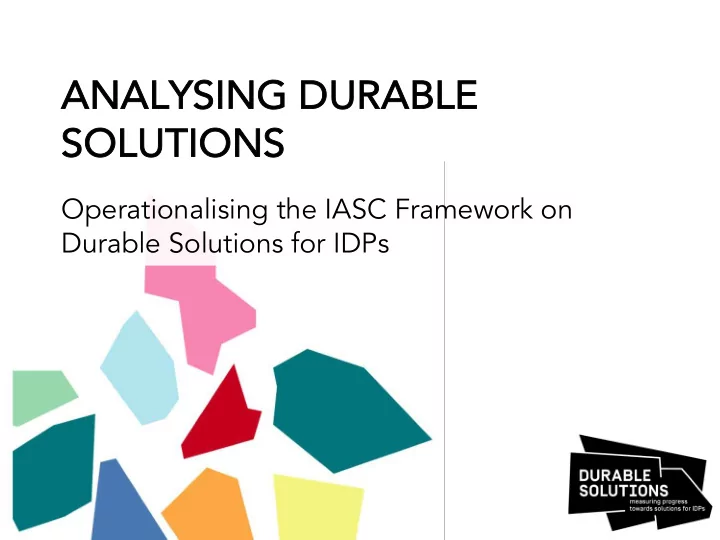

ANALY LYSING DURABLE LE SOLU LUTIONS Operationalising the IASC Framework on v Durable Solutions for IDPs
The Indicator Library and Analysis Guide were developed through a multi- stakeholder effort led by the Ma Mandate of the UN Specia ial l Rapporteur on the hum human r n right hts o of I IDPs . Coordinated and implemented by the Jo Joint ID IDP P Pr Profi filing Servi vice ce (JIPS JIPS) , the project involved development and humanitarian actors as well as academia, governments and local authorities.
What are Durable Solutions? • Exe xercise : Voting with your feet
Wh What at ar are durab able sol olution ons? Definition and principles based on the IASC Framework on Durable Solutions for IDPs and the Guiding Principles on Internal Displacement (#28 – 30)
The definition of durable solutions ‘ A durable solution is achieved when IDPs no longer have any specific assistance and protection needs that are linke ked to their displacement and can enjoy their human rights wi with thout t di discri rimi minati tion on account of their displacement.’
Three durable solutions options A durable solution can be achieved through:
Eight criteria to define to which extent solutions have been achieved A mere physical movement does not amount to a durable solution. IDPs who have reached a durable solution will enjoy without discrimination: v
Wh Why & & how ow might we we meas asure du dura rabl ble soluti tions? Operationalising the IASC Framework: The Durable Solutions Indicator Library & Analysis Guide
Why measure durable solutions? Analysis of Durable Solutions can inform policy, strategy, programming and advocacy, by producing: - Bas Baseline indicato ators rs for an analysis of key challenges for achieving solutions in a given moment; - Outcome i Out e ind ndicators to inform programming; - Mo Monit itorin ing of progress towards solutions over time to inform collective results . v
What questions can a durable solutions analysis answer? To which extent have displaced persons overcome discrimination, • assistance and protection needs linked to their displacement, and achieved lo local l (re)in integratio ion ? What are the remaining ke key obstacles to reaching solutions for • displaced persons? What are the fu future in intentio ions and plans of the displaced, and what • skills and capacities do they have to support their preferred solutions. How fe feasib ible le are the different durable solution options? •
A multi-stakeholder project to operationalize the IASC Framework v
Practical tools for comprehensive analysis v
What are the building blocks ks of du dura rabl ble soluti tions analysis? A collaborative and tailored-to-the-context analysis process
1. A collaborative process Government-led and engaging communities
2. A holistic & contextualized analysis
2. A holistic & contextualized analysis Including: I. THE PREFERENCE I. CES OF IDP IDPS According to the IASC Framework, k, durable solutions should be ba based d on the ”actual pr preferences of the IDPs”. Hence understanding their preferences and intentions is key. This includes understanding the factors that shape decision maki king as well as IDPs’ own capacities to address the preferences. This also links to article 28 in the Guiding Principles on Internal Displacement, on the right of IDPs to be involved in the planning and management of durable solutions for them.
2. A holistic & contextualized analysis Including: II. A COMPARTATIVE ANALY LYSIS OF THE DISPLA LACED AND NON NON-DISPLA LACED POPULA LATIONS ACROSS THE 8 IASC CRITERIA. The comparative analysis helps to understand in which areas displaced populations still face displacement-linked challenges and in which areas all populations face similar challenges. The Durable Solutions Indicator Li Library provides indicators for each of the eight IASC criteria. They can be contextualized and adapted to each setting, and are also aligned with the SD SDG ind ndicators .
2. A holistic & contextualized analysis Including: III. A DEMOGRAPHIC PROFILE LE OF THE DISPLA LACED POPULA LATION This allows to di disaggr ggrega gate the analysis across the IASC criteria by sex, age and other relevant diversity criteria e.g. location, vulnerability, tenure arrangement, etc.
2. A holistic & contextualized analysis Including: IV IV. MACR ACRO-LE LEVEL/ L/CONTEXTUAL L ANALY LYSIS Based on qualitative data and secondary sources, key informant interviews and urban analysis to look at: policies, legal frameworks, economy, built environment, service provision, social cohesion etc. Thus a mixe xed methods approach is recommended to combine the population profile of the displaced (typically based on a sample based household survey) with a macro level analysis.
Wh Which tool ools may ay I use? Combined efforts to measure solutions to displacement, but different objectives and methodologies.
Check out the indicator library: www. www.infor orm-du dura rabl blesoluti tions-id idp.org rg v
Recommend
More recommend